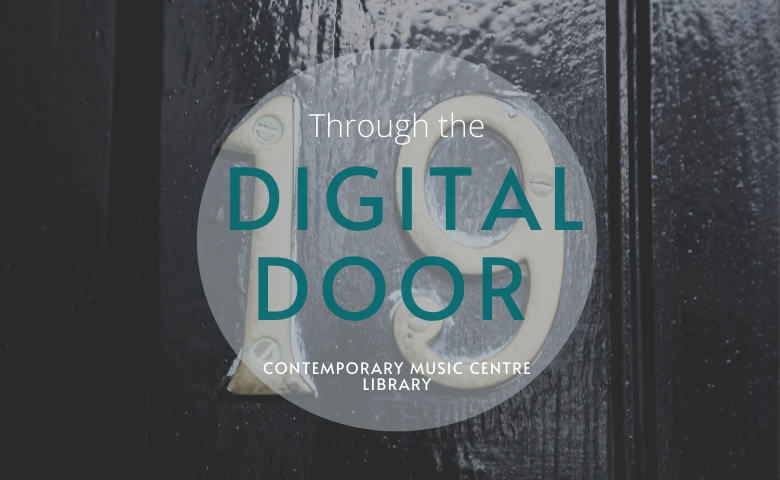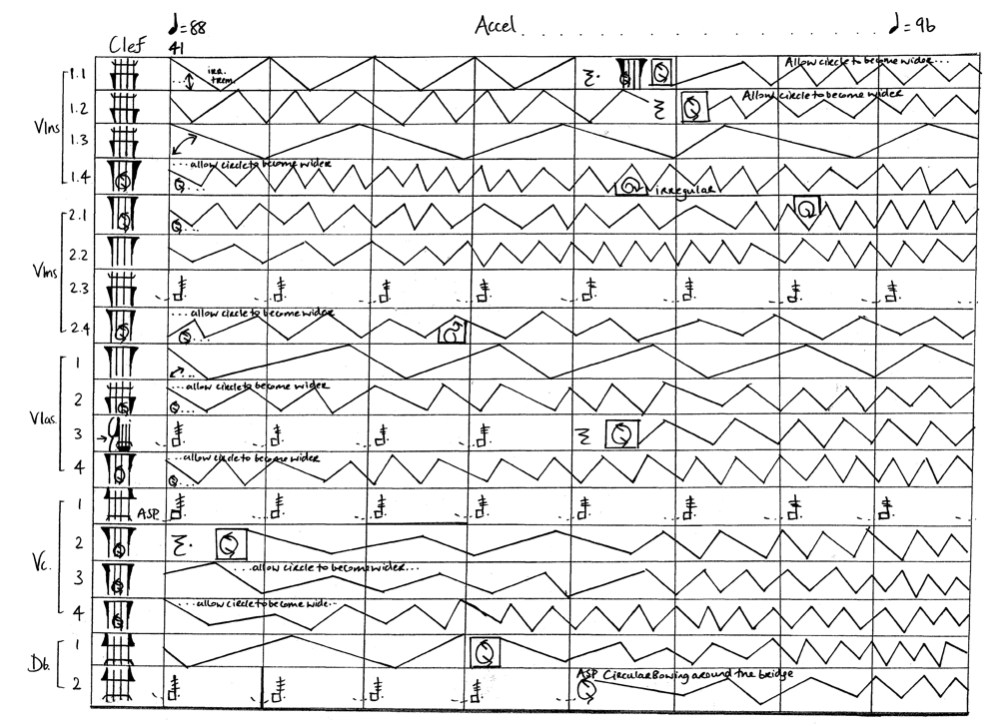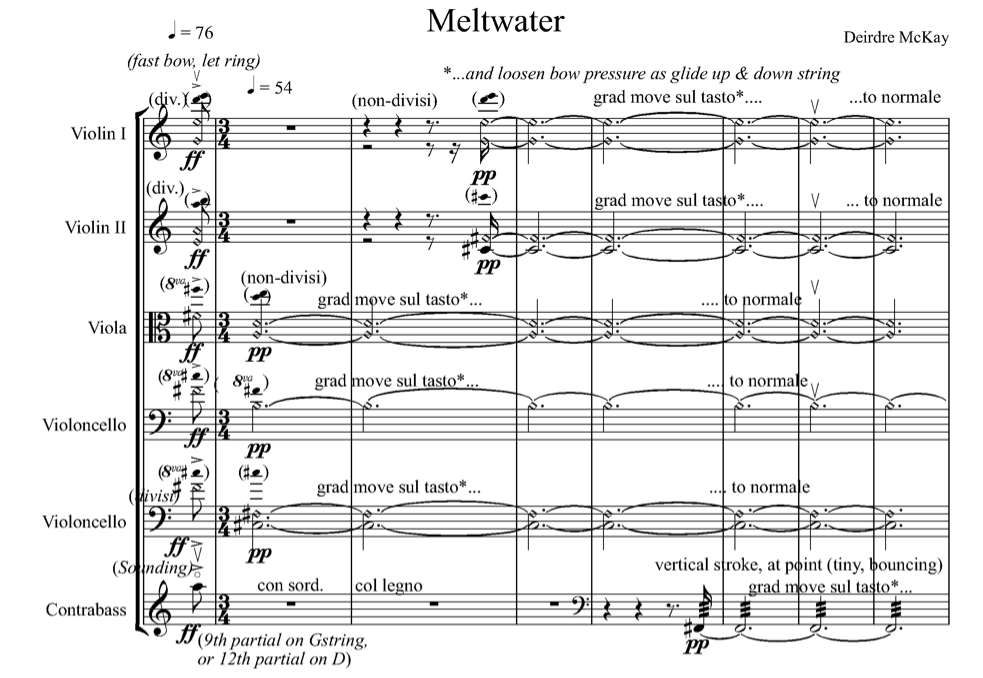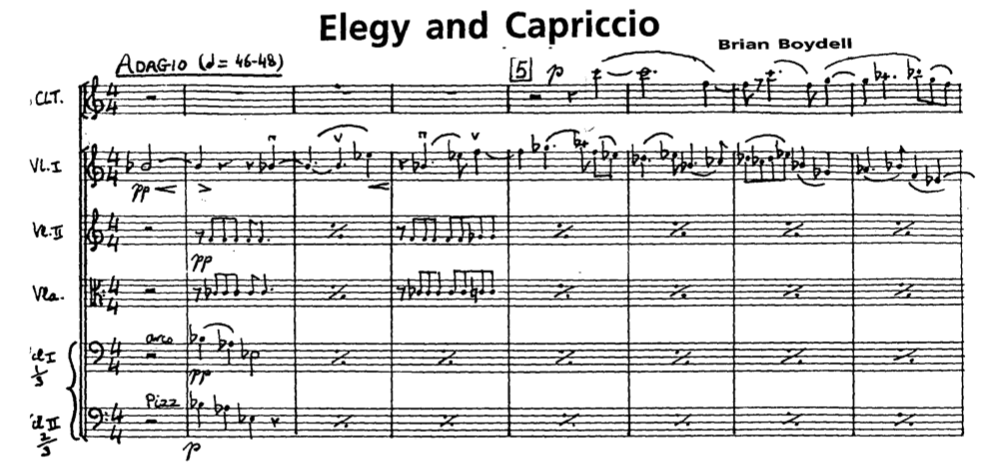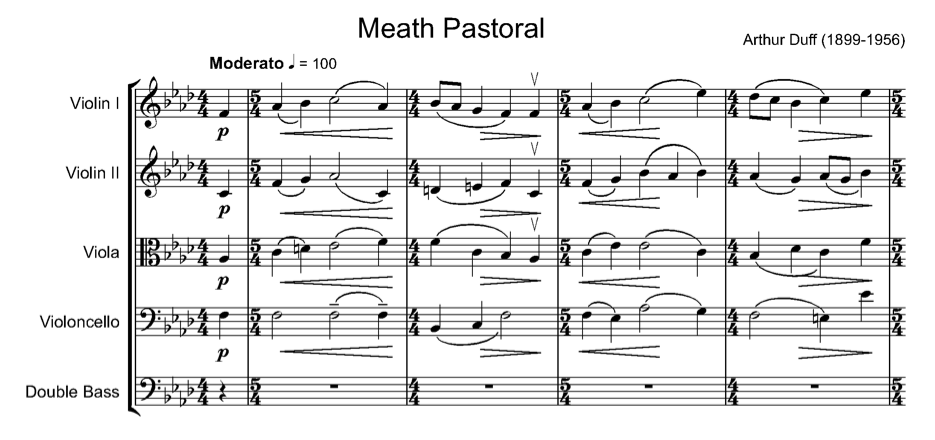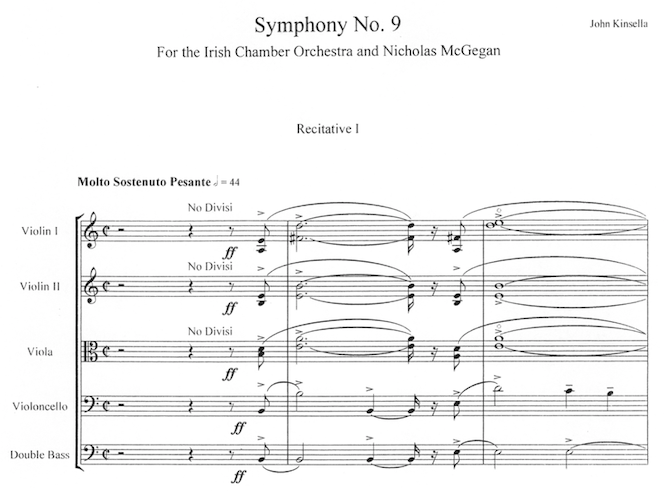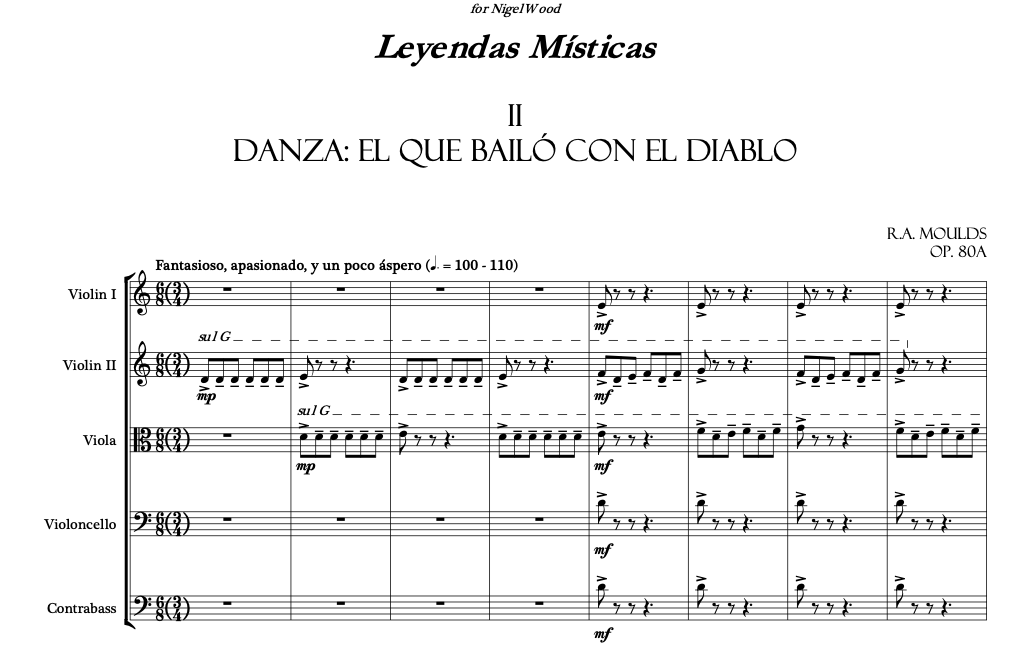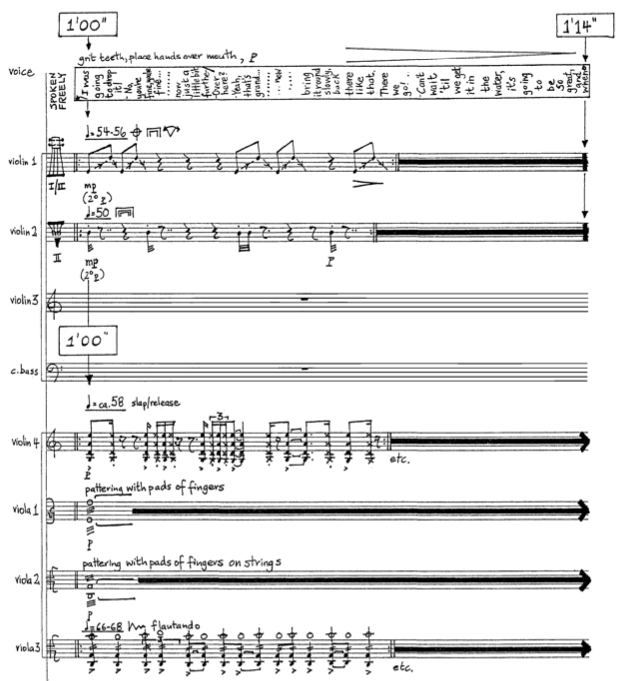Through the Digital Door: works for String Orchestra in CMC's Library (Part Two)
This week's Through the Digital Door is the second of a two-part feature looking at works for string orchestra. These works cover a broad range of styles and date from 1956 to 2019. Last week's part one can be found here.
Ann Cleare Claustrophobia (2005-2006) 25'
This work is in four movements for string orchestra and was the winner of the IMRO/Feis Ceoil Composition Competition in 2007. The composer explains the background to the work:
In Claustrophobia, I sought to create spatial music where there is rarely any real sense of time, just four immense landscapes of sound. I decided to base each movement of the work on one particular texture and attempt to develop this one texture throughout each movement, as if the same material was constantly reinvented or represented in a new way, from very gradual changes to completely overturning the texture’s colour and energy level.
Deirdre McKay Meltwater (2008 rev. 2009) 12'
This work was commissioned by the Irish Chamber Orchestra and premiered by the ICO with conductor Jaime Martin in the National Concert Hall in February 2009. This work unusually comes with two partnering scores: one reflecting the sounding pitches and one with the played/written harmonics, corresponding with players' parts.
Brian Boydell Elegy and Capriccio Op. 42 (1956) 14' for solo clarinet and string orchestra
This work was premiered by Michele Incenzo (cl), the Dublin Chamber Orchestra and conductor Herbert Póche in the Phoenix Hall in Dublin. The Elegy may also be performed as a solo work.
The Capriccio, which is a spikey allegro making much use of harmonies built on the interval of a fourth, was written first. The Elegy was then composed as a complete contrast: its long singing melodies running in counterpoint between the solo clarinet and first violins over euphonious harmonies which set off the more acerbic sound of the Capriccio. The Elegy has a free recitative-like middle section, and this movement is technically far simpler than the more virtuosic Capriccio making it possible for amateur players to perform the first movement alone, as was done by the Dublin Orchestral Players with Sydney Egan as soloist in l961.
Jane O’Leary Snapshots (2003) 9'
This work was written for the musicians of the RIAM Chamber Orchestra and their director Liz Csibi, during the composer's time as Composer-in-Residence at the RIAM. It consists of four movements: Born in light; But Why?; Some echo...; and Hope is.... This work should be performed with narration of text/poetry before each movement, as detailed in the programme note which accompanies the work:
The first movement connects to excerpts from Brendan Kennelly’s poem Begin. It is full of optimism, reminding us that despite all setbacks, we will always seek a new beginning. The second movement recalls a short poem from Kennelly’s collection ‘A Drinking Cup’ (1970) - translations from old Irish. While I was writing this music, the invasion of Iraq took place, with long term implications for the world. I wondered ‘why?’ The third movement relates to a work by Moya Cannon, who was based in Galway at the time. How can we explain the echoes from the past that lead us towards our destiny? It is the poetry of Emily Dickinson which inspires the final movement - despite everything, there is always hope. We return to the ever-present optimism of the opening movement.
Arthur Duff Meath Pastoral (1940) 5'
This work was premiered in November 1994 in the RDS by Dublin String Orchestra, conducted by Terry O'Connor.
Meath Pastoral is a simple, five-minute piece for strings. It reiterates a melancholy folk melody which Duff sets in the pastoral style, a brief contrasting middle section betraying hints of another of his enthusiasms, the music of the baroque era. Duff wrote the piece as an act of thanksgiving for the deliverance of Ireland from invasion in 1940.
Marian Ingoldsby However Long that Dark (1994) 9'
This work was commissioned and premiered by the Irish Chamber Orchestra, and the title was inspired by a poem of Eithne Strong. It was premiered in November 1994 in Graiguenamangh, Co. Kilkenny.
The poem begins with the ideas of 'black night' and 'great pain'. In the music, these are represented by harsh chords in the upper strings against pulsating cellos and basses. Generally, the poem describes a state of mind where all is gloomy and sombre, but this is followed by a note of hope and reassurance. There is a complete turnabout during the piece, which was originally composed as a sort of 'Musical Anadin'. The image of a melting stone towards the end reflects a state where there has been a jolt out of depression into a tranquil place.
John Kinsella Symphony No. 9 (2004) 30'
John Kinsella's Ninth Symphony is scored for string orchestra, and was commissioned by and premiered by the Irish Chamber Orchestra.
There are three main movements - Scherzo impetuoso, with much use of sul ponticello effects in the central section, Largo and Allegro con moto, which is marked throughout by a persistent rhythmic figure. Each of these is preceded by a recitative-like section, the first being the most elaborate. Throughout the symphony, the original material is interwoven with motifs taken from two versions of the hymn tune “Jesu, meine Freude. The first of these, which is encountered in the earlier parts of the work, is the original version by Johann Cruger, published in 1653. Later, motifs from the second version, J.S. Bach’s chorale setting, are used within the texture of the music, until finally, this emerges complete. played by a quartet of three violas and ‘cello underpinned by the characteristic rhythm of the movement and punctuates with comments from the orchestra. A short emphatic Coda marked vivace then completes the symphony.
R.A. (Rod) Moulds Danza: El que bailó con el Diablo Op. 80a (2003) 6'
Written in 2003, this work was first written for saxophone quartet, and subsequently adapted for both string orchestra and string quartet. This work is the second of four works for varying orchestral groups in a series entitled Leyendas Místicas:
The series Leyendas Místicas overtly and subtly make reference to Hispanic and Latin American music, locations and culture.
Jennifer Walshe Ná dean NÍL CEAD (2001) 16' for voice and string orchestra
Commissioned by Westdeutscher Rundfunk Köln, this work was premiered in 2002 in Wittener Tage für Neue Kammermusik by Jennifer Walshe and Ensemble Resonanz.
In this piece, I was very interested in exploring sounds which are inhibited in some way. By this, I mean sounds that result from the performer trying to perform a standard sound, but modifying their actions in such a way that a different sound results. For example, a violinist might play a pitch using very light bow pressure, or the vocalist might cover their mouth with their hands or grit their teeth whilst singing. The title is grammatically incorrect Irish. It literally means "don't do permission isn't."
David Fennessy Hirta Rounds (2015) 12'
This work was commissioned by the Münchener Kammerorchester, funded by the Ernst von Siemens Music Foundation, and was premiered by the Münchener Kammerorchester in July 2015. The piece is unconducted. This work is published by Universal Edition.
In 2015 the Munich Chamber Orchestra invited me to compose a new concert piece for strings with the stipulation that it be unconducted. This aspect was crucial key in the conception of the entire piece and it led to me to think about how I could write chamber music for sixteen individual players. Splitting the strings into smaller groups opened up the possibility of many different fluctuations in tempo occurring simultaneously and what has resulted is at once some of the most simple yet complex music I have composed thus far. The title refers to the remote island of Hirta, in the St Kilda archipelago, off the Atlantic coast of Scotland. For centuries a small community thrived there, however in 1930 they were finally forced to evacuate. Today, only the shells of their stone houses remain on this otherwise barren rock in the middle of the ocean, and one can almost sense the traces of a once vibrant society.
Sam Perkin Waves (2017) 17' for solo percussion and string orchestra
This work was commissioned by the Irish Chamber Orchestra and premiered in September 2017 in the National Concert Hall by the ICO, percussionist Alex Petcu and conductor Gábor Tacács-Nagy. The work was composed as 'a balm for tinnitus'.
Tinnitus is the hearing of sound when no sound is present. As a composer, hearing these phantom sounds, which started a year ago for me, can be frustrating. They can make composing, conversing, and sleeping quite difficult. Some people find that white noise, rainfall or ocean waves can help to mask these sound mirages. The ocean wave sounds worked for me, and I listened to them a lot. Over 365 days, while I had them flowing through my mind, I took these sounds from nature, that I cherish so much, and composed a work that is entirely made up of these beautiful patterns, in essence, 365 variations on a wave gesture. The ebb and flow in the music comes from the true rhythm of nature, and in the way it mysteriously varies itself. I attempted to harness these natural forces to create a work in which we can be in awe of nature’s secrets, but also a work that, who knows, can maybe cure tinnitus.

